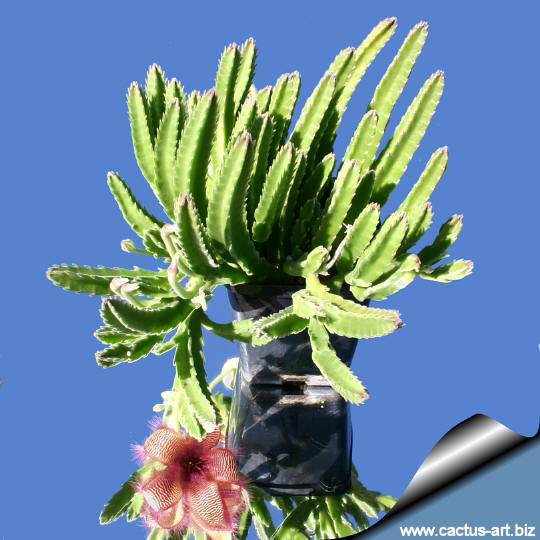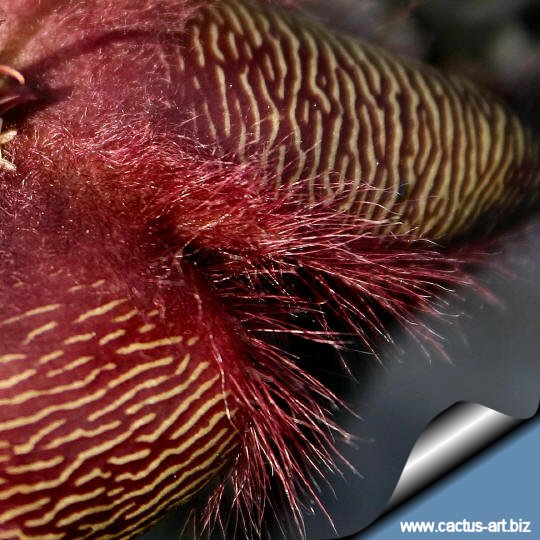|
|
Family:
Asclepiadaceae (Apocynaceae)
(Milkweeds family)
Scientific Name (and
Basionym):
Stapelia
hirsuta
Linn. 1737
Published in: Species Plantarum 217., 1737
Type:
Lectotype.
Conserved at the The George Clifford
Herbarium
Barcode: BM000558154 -
HC Page No.: 77 -
HC Name: Stapelia 2
No. Sheets: 1 -
Typedes ref: Brown in Harvey & Sonder (eds.) Fl. Cap. 4(1): 939, 1909.
Distribution: This species is in nature limited to the
South/western Cape Province of South Africa.
Habitat: From winter rainfall area.
S. hirsuta
was (along with
S.
variegata
later transferred to the
genus
Orbea) the
second stapeliads to be discovered. Linnaeus then
described and
set up the the new genus
Stapelia in 1737 and based the genus on
S. hirsuta that now stands for the
type species
of the genus.
Vernacular name (s):
Starfish flower,
Carrion Plant
Etymology:
The
genus
epithet "Stapelia"
was named
in honour of Johannes van Stapel, who published drawings
and descriptions of the first Stapeliae discovered (Orbea
variegata)The
species name derives from the Latin adjective “hirsutus” meaning
"rough, shaggy, bristly” (The specific name
implies:
“hairy” )
|
|
|
|
Habit:
Groundcover,
clump forming.
Stem: The plant quickly throws up
subquadrangular stems
which redden in
full sun
and during the
winter month.
Flower: Dark-red, flat and densely covered by long
hair
at the centre that remember the fur of a dead animal.
Corolla
width very variable, from 5-15 cm (usually10/12 cm) across and
very deeply
lobed. The moderate carrion
smell of the flowers
attracts
flies which may lay eggs on the flower. Sometimes fly
larvae that have hatched from the eggs can be seen on the
flower.
Fruit:
Flies pollinate the flowers resulting in the
typical twin seed horns (follicles), which are decorative in
themselves and often don't appear until a year later.
Seeds: The pant readily produces seed which
germinates 100% if sown
when fresh.
Phenology:
Blossoming time: Flowers are freely produced throughout the
late
summer and
autumn.
Notes: S. hirsuta is a very variable
species with many
hybrids both in the
wild and
in cultivation.

|
|

|
|
Cultivation: Together with
Stapelia gigantea and
Orbea variegata, probably the most widely cultivated of
stapeliads. It is an easy obliging
blooming plant when
mature, they are happy in any average succulent house.
Stapelia require moderately watering through the
growing season but enjoy plenty of water and some
fertiliser in hot
weather, this helps them to
flower freely. Water more sparingly in winter according to
temperatures. But, as with most
asclepiads, it is unwise to leave them wet in cold weather.
Winter care presents no problems at 5°C with plenty of light. Since
roots are quite shallow, use a
cactus mix or add extra
perlite or
pumice to regular soil
potting soil. A gritty, very free-draining
compost is suitable, and
clay pots help the plants to dry out between watering.
Sun Exposure: Partial sun or
light shade
Pest and
diseases: Stapelia species vary in their
susceptibility to
rotting, but are generally fairly easy to grow, especially
if kept
pest-free. They are very
susceptible to stem and root
mealy bugs, and damage from these may well initiate
fungal
attack. If you do have problems with a stem or with basal
rotting, you can reliably isolate the
healthy parts, dry them off, and
re-root them in moist
compost.
Cultural Practices:
Re-pot every 2 years
|
|